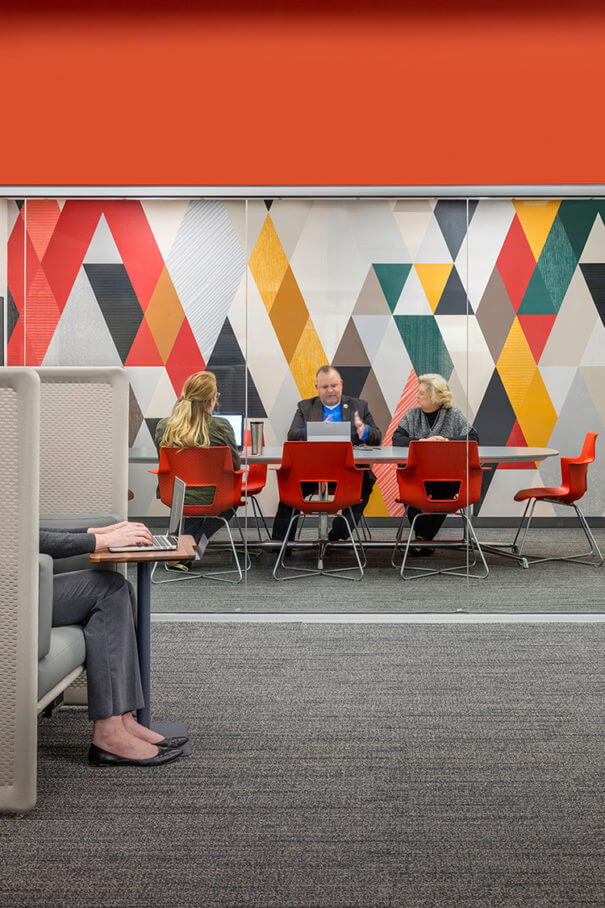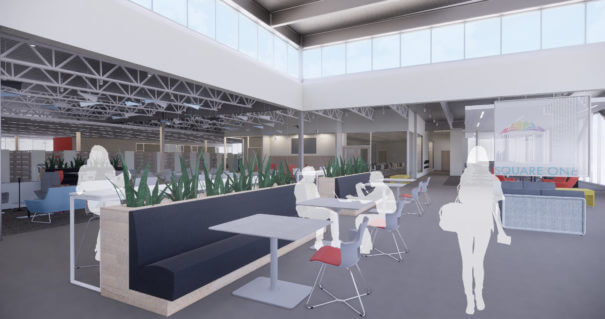Building Community: Kansas City’s largest public library system evolves in the face of change
In honor of National Library Week, Helix is celebrating the largest library system in the Kansas City metro area, Mid-Continent Public Library (MCPL), in a two-part blog series that highlights MCPL’s role as a cornerstone of the communities it serves.
Always striving to be on the leading edge, MCPL laid out an ambitious capital improvement plan to modernize and reposition its broad network of branches, including renovating 21 existing buildings and replacing or adding 11 new ones. Five years after Helix and SAPP Design Architects were selected to carry out MCPL’s grand vision , Helix project manager and interior designer Taylore Keller and MCPL Library Director and CEO Steve Potter took pause to reflect on the ways in which MCPL continuously evolves in response to challenges.

Advent of Technology
“Certainly, technology has been the big disruptor during the course of my career,” Potter said. “One of the very first things we started looking at was content. How can we get new digital content that broadens access? You can provide amazing access to people. It frees up all kinds of space for you to do other things.”
MCPL began purchasing digital licenses to replace the hard copies that resided on dozens of its stacks. For example, three months’ worth of copies of The Kansas City Star could now be supplanted by digital versions of every issue of The Star dating back to 1880.
“In terms of storage on our shelves, this is zero. And it’s all available here,” Potter said, pointing to his smartphone.


“That gives us all kinds of great opportunities: collaboration rooms, community rooms, individual space, differing space so that you can have furniture for people of all different sizes.”
A Right-Sized Approach
“If we don’t have to have all of this [space]… you can do new and creative things with your buildings,” Potter said. “That was where a lot of the genesis of our capital improvement and replacement plan came from.”
At the beginning of his career, Potter noted, the smallest library footprint needed to be anywhere from 17,000 SF to 20,000 SF. Across its 32 branches, some of MCPL’s buildings were 15,000 SF, which felt too small to house the vast amount of physical copies needed for collections and to hold community outreach events. Incorporating digital content opened up new possibilities for branches that were once thought to not have enough space.
“Those buildings were always under-configured, and now they’re just the right size,” Potter said. “That gives us all kinds of great opportunities: collaboration rooms, community rooms, individual space, differing space so that you can have furniture for people of all different sizes. That really wasn’t possible because your footprint was so confined by the amount of shelving you had to keep.”

Creating Community Destinations
After completing a strategic analysis of the entire library system, MCPL identified a number of ways in which it could change the idea of the “traditional” library and offer a more robust experience. New destination branches, each with a specific focus, were developed to address gaps in community services.
Colbern Road – SquareOne Coworking Destination
The Colbern Road Library Center will serve as the headquarters for SquareOne, a division of MCPL that offers an array of resources to budding entrepreneurs and start-ups.
“We are going to focus on helping people take a chance on themselves,” Potter said.
Potter refers to SquareOne staff as “nomads,” traveling to meet entrepreneurs wherever their business may take place. “But even nomads have to have a place to go,” Potter said.
Within Colbern Road, SquareOne will have a home base where staff can recharge, replenish supplies, and touch down between client meetings. They will also have the opportunity to do programming and facilitate connections between start-ups. As a hybrid library and workplace, progressive tenets of workplace design are incorporated into the interiors, where people can temporarily cowork.


Green Hills – Culinary Literacy Center
An inherent goal of the Green Hills Library Center is to improve patron health by inspiring them to prepare healthy meals through interactive demonstrations. This education extends to the children’s area, which incorporates playful seating that features healthy produce.
“The really exciting thing is going to be in the incubator kitchens and the teaching kitchen,” Potter said. “People can see these budding entrepreneurs doing their thing right there, or, in terms of teaching and culinary literacy, just walk by and see what’s going on.”
Woodneath Library Center – Story Center
“Our Story Center is centered around the idea of building a community of people who are trying to learn the skills of written and oral storytelling,” Potter said. “The work they do, the art that they do, is a positive byproduct of the fact that we are gathering this community of people who can… help each other tell their stories and tell them in creative ways.”
The form of the auditorium is influenced by the topography of the surrounding farmland, with an undulating ceiling at varied depths to emulate fields in various growth cycles. Materials are simple and resemble those found in the site — wood, green textures, and colors that evoke elements like the sky or earth.

“They’re beginning to look at the library not exclusively as a material delivery system or as an information delivery system, but they’re also looking at the library as a place to build community.”
Years of progressive thinking and a forward-looking approach equipped MCPL to weather the challenges of the pandemic. We will share more about how MCPL adapted and their plans for the future in our next blog.